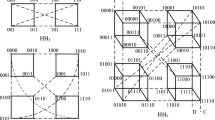Abstract
In the paper “Fault-free Mutually Independent Hamiltonian Cycles in Hypercubes with Faulty Edges” (J. Comb. Optim. 13:153–162, 2007), the authors claimed that an n-dimensional hypercube can be embedded with (n−1−f)-mutually independent Hamiltonian cycles when f≤n−2 faulty edges may occur accidentally. However, there are two mistakes in their proof. In this paper, we give examples to explain why the proof is deficient. Then we present a correct proof.
Similar content being viewed by others
References
Akers SB, Krishnameurthy B (1989) A group-theoretic model for symmetric interconnection networks. IEEE Trans Comput 38:555–566
Bondy JA, Murty USR (1980) Graph theory with applications. North-Holland, New York
Chang C-H, Lin C-K, Huang H-M, Hsu L-H (2004) The super laceability of hyper-cubes. Inf Process Lett 92:15–21
Hsieh S-Y, Yu P-Y (2007) Fault-free mutually independent Hamiltonian cycles in hypercubes with faulty edges. J Comb Optim 13:153–162
Johnsson SL, Ho C-T (1989) Optimum broadcasting and personalized communication in hypercubes. IEEE Trans Comput 38:1249–1268
Leighton FT (1992) Introduction to parallel algorithms and architectures: arrays, trees, hypercubes. Kaufmann, San Mateo
Leu Y, Kuo S (1999) Distributed fault-tolerant ring embedding and reconfiguration in hypercubes. IEEE Trans Comput 48:81–88
Lewinter M, Widulski W (1997) Hyper-Hamilton laceable and caterpillar-spannable product graphs. Comput Math Appl 34:99–104
Simmons G (1978) Almost all n-dimensional rectangular lattices are Hamilton laceable. Congres Numer 21:103–108
Sun C-M, Lin C-K, Huang H-M, Hsu L-H (2006) Mutually independent Hamiltonian paths and cycles in hypercubes. J Interconnect Netw 7(2):235–255
Tsai C-H, Tan JJM, Linag T, Hsu L-H (2002) Fault-tolerant Hamiltonian laceability of hypercubes. Inf Process Lett 83:301–306
Yang P-J, Tien S-B, Raghavendra CS (1994) Embedding of rings and meshes onto faulty hypercubes using free dimensions. IEEE Trans Comput 43:608–613
Author information
Authors and Affiliations
Corresponding author
Additional information
This work was supported in part by the National Science Council of the Republic of China under Contract NSC 95-2221-E-233-002.
Rights and permissions
About this article
Cite this article
Kueng, TL., Lin, CK., Liang, T. et al. A note on fault-free mutually independent Hamiltonian cycles in hypercubes with faulty edges. J Comb Optim 17, 312–322 (2009). https://doi.org/10.1007/s10878-007-9113-1
Published:
Issue Date:
DOI: https://doi.org/10.1007/s10878-007-9113-1



